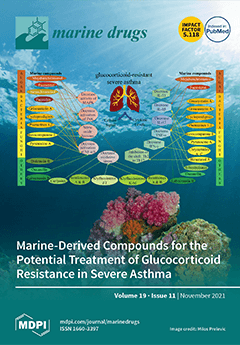Biofouling, which occurs when certain marine species attach and accumulate in artificial submerged structures, represents a serious economic and environmental issue worldwide. The discovery of new non-toxic and eco-friendly antifouling systems to control or prevent biofouling is, therefore, a practical and urgent need.
[...] Read more.
Biofouling, which occurs when certain marine species attach and accumulate in artificial submerged structures, represents a serious economic and environmental issue worldwide. The discovery of new non-toxic and eco-friendly antifouling systems to control or prevent biofouling is, therefore, a practical and urgent need. In this work, the antifouling activity of a series of 24 xanthones, with chemical similarities to natural products, was exploited. Nine (
1,
2,
4,
6,
8,
16,
19,
21, and
23) of the tested xanthones presented highly significant anti-settlement responses at 50 μM against the settlement of mussel
Mytilus galloprovincialis larvae and low toxicity to this macrofouling species. Xanthones
21 and
23 emerged as the most effective larval settlement inhibitors (EC
50 = 7.28 and 3.57 µM, respectively). Additionally, xanthone
23 exhibited a therapeutic ratio (LC
50/EC
50) > 15, as required by the US Navy program attesting its suitability as natural antifouling agents. From the nine tested xanthones, none of the compounds were found to significantly inhibit the growth of the marine biofilm-forming bacterial strains tested. Xanthones
4,
6,
8,
16,
19,
21, and
23 were found to be non-toxic to the marine non-target species
Artemia salina (<10% mortality at 50 μM). Insights on the antifouling mode of action of the hit xanthones
21 and
23 suggest that these two compounds affected similar molecular targets and cellular processes in mussel larvae, including that related to mussel adhesion capacity. This work exposes for the first time the relevance of C-1 aminated xanthones with a 3,4-dioxygenated pattern of substitution as new non-toxic products to prevent marine biofouling.
Full article






